- The x-axis represents the independent frequency variable.
- The left hand y-axis measures decibels with respect to milliwatts (dBm), correlating to dependent changes in intensity over time (right hand y-axis) of the measured frequencies.
- In addition, the dependent maximal detected signal in dBm in a given frequency over the entire sampling period is represented by the yellow dots, which map back to the left hand y-axis.
For about a year and a half, I worked as a Research Associate in the Spectrum Policy Program at the New America Foundation, in Washington, DC. The program's mission is outlined here and boils down to the development of public policy dedicated to defending and enhancing the public's role in radio spectrum management. This squared well with my background in engineering, and gave me a chance to do some writing / coding as well. The plots above were created a few months after I left as I sifted through old data from that spectrum hunt.
On June 10, 2003, I went with Mark McHenry of the Shared Spectrum Company up to the roof of the NAF building just north of Dupont Circle to take measurements of the emptiness of the radio spectrum in the two decades between 30MHz and 3GHz. (For non-engineers: a decade is an engineering unit measuring the separation between values. e.g. 30MHz to 300MHz is 1 decade, and 300MHz to 3000MHz is 1 more decade.)
Presented below are charts generated by Dr. McHenry's clever MATLAB code from the data collected that day, and the PHP script that I wrote to generate the two red-scaled PSD charts above. If you're interested in obtaining the data, please feel free to contact me or contact Shared Spectrum for more information.
Charts
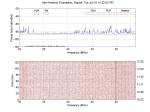 |
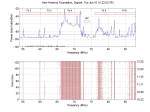 |
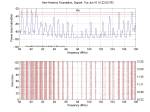 |
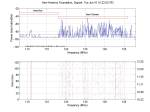 |
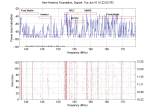 |
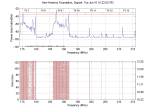 |
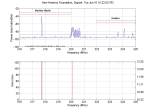 |
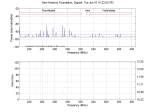 |
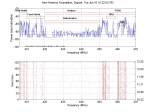 |
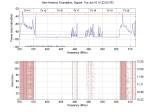 |
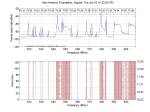 |
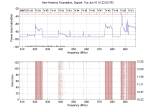 |
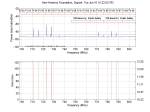 |
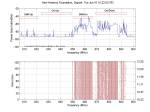 |
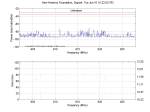 |
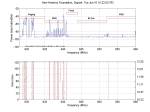 |
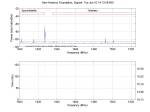 |
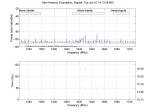 |
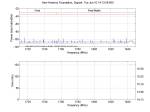 |
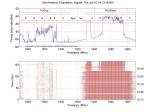 |
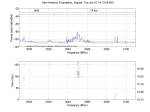 |
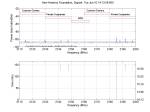 |
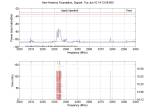 |
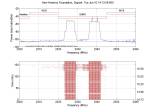 |
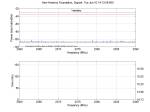 |
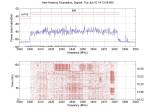 |
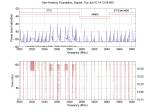 |
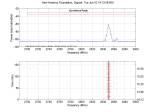 |
Photos
 |
 |
 |
 |
 |
 |
 |
 |
 |
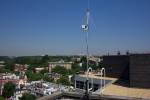 |
 |
 |
 |
As it turns out, the radio spectrum is a very empty place, with an overall utilization of only something like 20-30% (at the most), and most of that being used for narrowband applications or wasteful old analog modulated signals such as FM radio and analog broadcast television.
What's the point?
Well, consider this. Although digital satellite systems have been in existence for a while and demonstrated to be quite efficient with their channel modulation and packing schemes, terrestrial broadcasters have refused to pony up the money necessary to convert their ancient broadcast stations to digital. Why should a technology that is almost reaching 65 years of age still be allowed to operate with abhorrent efficiency?
Sitting on roughly 6 billion dollars worth of spectrum apiece, television broadcast stations are holding out for private property rights, believing, wrongfully, that they have a controlling interest in a limited natural resource. e.g. Contrary to the explicit rights granted to them in the Communications Act of 1934, broadcasters believe that they own the spectrum that they use.
Naturally, the last thing broadcasters want is to see competition, which is why, instead of letting more broadcasters onto the air and commodifying airwave time to an extent that actual competitive content made it on the air, you know, in support of better and stronger democracy, for instance, broadcasters grasp their spectrum licenses ever more tightly and by maintaining/eroding the status quo, halt the dissemination of more diverse viewpoints.
Granted, not all shows would survive, and not all upstart media networks would survive either, but as it stands, the airwaves simply represent a failed marketplace run by the industrial policies of the FCC and corrupt broadcasters.
For more evidence of this, look no further than Sinclair Broadcast Group's move to block its ABC affiliates from broadcasting a tribute to fallen U.S. soldiers in Iraq on Friday, April 30, 2004.
But not only do the broadcasters suck up precious low-frequency spectrum that could be much better tuned for the delivery of wireless broadband internet services, more and higher-definition channels using digital modulation, and services we haven't even invented yet, they also demand the free use of other people's delivery services through must-carry provisions levied on cable and satellite operators.
Well, I suppose not having ubiquitous broadband internet access or lower cost wireless service is a small price to pay in order for your local station to inefficiently blast Joe Millionaire into your bedroom.

